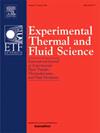An assessment of event-based imaging velocimetry for efficient estimation of low-dimensional coordinates in turbulent flows
IF 2.8
2区 工程技术
Q2 ENGINEERING, MECHANICAL
Experimental Thermal and Fluid Science
Pub Date : 2025-02-05
DOI:10.1016/j.expthermflusci.2025.111425
引用次数: 0
Abstract
This study explores the potential of neuromorphic Event-Based Vision (EBV) cameras for data-efficient representation of low-order model coordinates in turbulent flows. Unlike conventional imaging systems, EBV cameras asynchronously capture changes in temporal contrast at each pixel, delivering high-frequency output with reduced data bandwidth and enhanced sensitivity, particularly in low-light conditions. Pulsed Event-Based Imaging Velocimetry (EBIV) is assessed against traditional Particle Image Velocimetry (PIV) through two synchronized experiments: a submerged water jet and airflow around a square rib in a channel. The assessment includes a detailed comparison of flow statistics and spectral content, alongside an evaluation of reduced-order modeling capabilities using Proper Orthogonal Decomposition (POD). The event stream from the EBV camera is converted into pseudo-snapshots, from which velocity fields are computed using standard PIV processing techniques. These fields are then compared after interpolation onto a common grid. Modal analysis demonstrates that EBIV can successfully identify dominant flow structures, along with their energy and dynamics, accurately discerning singular values, spatial modes, and temporal modes. While noise contamination primarily affects higher modes – less critical for flow control applications – overall performance remains robust. Additionally, comparisons of Low-Order Reconstruction (LOR) validate EBIV’s capability to provide reliable reduced-order models of turbulent flows, essential for flow control purposes. These findings position EBV sensors as a promising technology for real-time, imaging-based closed-loop flow control systems.
求助全文
约1分钟内获得全文
求助全文
来源期刊

Experimental Thermal and Fluid Science
工程技术-工程:机械
CiteScore
6.70
自引率
3.10%
发文量
159
审稿时长
34 days
期刊介绍:
Experimental Thermal and Fluid Science provides a forum for research emphasizing experimental work that enhances fundamental understanding of heat transfer, thermodynamics, and fluid mechanics. In addition to the principal areas of research, the journal covers research results in related fields, including combined heat and mass transfer, flows with phase transition, micro- and nano-scale systems, multiphase flow, combustion, radiative transfer, porous media, cryogenics, turbulence, and novel experimental techniques.
 求助内容:
求助内容: 应助结果提醒方式:
应助结果提醒方式:


